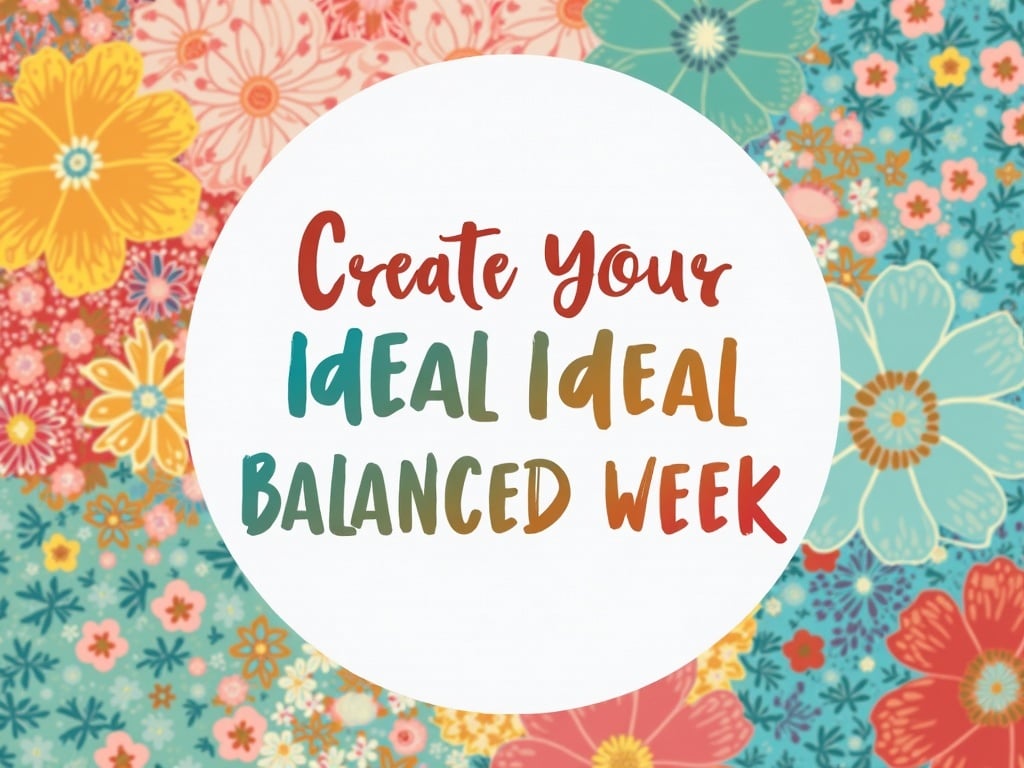How to Create Your Ideal Balanced Week: A Step-by-Step Guide
Imagine a week where you feel energized, accomplished, and genuinely happy. No more Sunday night dread, no more mid-week burnout. Just a rhythm of work, rest, and play that leaves you feeling fulfilled. Sounds impossible? It's not. Creating your ideal balanced week is within reach, and this guide will show you exactly how to achieve it.
Understanding What Balanced Truly Means For You
Forget the cookie-cutter definitions of work-life balance. What truly matters is what balanced means to you. It's a deeply personal equation, factoring in your values, priorities, and individual needs. Before diving into scheduling, let's explore some key areas:
Identifying Your Core Values
What's truly important to you? Family? Career? Health? Creativity? Spirituality? Knowing your core values provides a compass for your decisions and ensures your week aligns with what you hold dear. Take some time to reflect and write down your top 3-5 values. For example:
- Family: Spending quality time with loved ones, creating lasting memories.
- Health: Prioritizing physical and mental well-being through exercise, nutrition, and mindfulness.
- Growth: Continuously learning, developing new skills, and expanding your horizons.
- Contribution: Making a positive impact on your community or the world.
- Creativity: Expressing yourself through art, music, writing, or other creative outlets.
Assessing Your Current Week: Where Are You Spending Your Time?
Honest self-assessment is crucial. Track your time for a week. Be meticulous. Use a digital time tracker, a spreadsheet, or even a simple notebook. Categorize your activities (work, commuting, family time, hobbies, sleep, etc.). At the end of the week, analyze the data. Are you surprised by where your time goes? Are your current activities aligned with your core values?
Recognizing Your Energy Levels and Rhythms
We all have natural energy fluctuations throughout the day and week. Are you a morning person or a night owl? When do you feel most productive? Understanding your energy rhythms allows you to schedule demanding tasks during peak performance times and reserve lower-energy periods for less intensive activities. Consider experimenting with different schedules to find what works best for you.
Building Your Balanced Week: A Practical Guide
Now that you've clarified your values and assessed your current situation, it's time to design your ideal week. Here's a step-by-step approach:
1. Start with the Essentials: Sleep, Nutrition, and Movement
These are the non-negotiables. Prioritize sleep by establishing a consistent bedtime routine. Prepare healthy meals and snacks to fuel your body and mind. Schedule regular exercise, even if it's just a 30-minute walk each day. These foundational elements are critical for sustained energy and well-being. Neglecting them will undermine your efforts to create a balanced week.
2. Block Scheduling: Allocate Time for Key Activities
Block scheduling involves dividing your week into dedicated blocks of time for specific activities. This provides structure and helps you ensure that all your priorities receive attention. Consider these categories:
- Work: Allocate time for focused work, meetings, and administrative tasks.
- Family/Relationships: Schedule dedicated time for family meals, outings, or quality time with loved ones.
- Personal Development: Dedicate time for learning, reading, or pursuing hobbies.
- Self-Care: Schedule time for relaxation, mindfulness, or activities that bring you joy.
- Social: Make time for connecting with friends and building your social network.
Be realistic and flexible. Don't try to cram too much into each day. Allow for buffer time to handle unexpected events or simply to relax and recharge.
3. Theming Your Days: Focus and Efficiency
Consider theming your days to streamline your activities. For example:
- Monday: Focus on administrative tasks, planning, and setting priorities for the week.
- Tuesday & Wednesday: Dedicate to deep work and project execution.
- Thursday: Meetings, networking, and collaboration.
- Friday: Wrap up projects, prepare for the weekend, and reflect on the week's accomplishments.
Theming can help you minimize context switching and improve focus, leading to increased productivity and a greater sense of accomplishment.
4. Saying No: Protect Your Time and Energy
Learning to say no is essential for maintaining balance. Don't overcommit yourself to activities that drain your energy or don't align with your priorities. Politely decline requests that don't serve your goals and protect your time for the things that truly matter. Remember, every yes to something is a no to something else.

5. Incorporate Mindfulness and Downtime
In our hectic world, it's easy to get caught up in the constant rush. Make time for mindfulness practices like meditation, deep breathing, or simply taking a few moments to appreciate the present moment. Schedule regular downtime to relax, unwind, and recharge your batteries. This could involve reading a book, listening to music, spending time in nature, or engaging in hobbies you enjoy. Actively scheduling these activities prevents them from being pushed aside.
Tools and Techniques for Maintaining Balance
Creating a balanced week is an ongoing process, not a one-time event. Here are some tools and techniques to help you stay on track:
Time Management Apps and Planners
Utilize time management apps like Google Calendar, Todoist, or Asana to schedule your activities, set reminders, and track your progress. Experiment with different planner styles (digital or paper) to find what works best for you. A visual representation of your week can help you stay organized and motivated.
The Eisenhower Matrix: Prioritize Your Tasks
The Eisenhower Matrix (also known as the Urgent-Important Matrix) is a powerful tool for prioritizing tasks. Divide your tasks into four categories:
- Urgent and Important: Do these tasks immediately.
- Important but Not Urgent: Schedule these tasks for later.
- Urgent but Not Important: Delegate these tasks to someone else.
- Neither Urgent nor Important: Eliminate these tasks.
Using the Eisenhower Matrix helps you focus on the most critical tasks and avoid getting bogged down in less important activities.
Batching Similar Tasks: Improve Efficiency
Batch similar tasks together to minimize context switching and improve efficiency. For example, dedicate a specific block of time to answering emails, making phone calls, or working on a particular project. This allows you to enter a state of flow and accomplish more in less time.
Regular Review and Adjustment: Adapt to Changing Needs
Your ideal balanced week will likely evolve over time as your priorities and circumstances change. Regularly review your schedule and make adjustments as needed. Be honest with yourself about what's working and what's not. Don't be afraid to experiment and try new approaches until you find a rhythm that truly supports your well-being.
Common Pitfalls and How to Avoid Them
Creating a balanced week isn't always easy. Here are some common pitfalls to watch out for:
Perfectionism: Striving for the Impossible
Don't aim for perfection. A balanced week doesn't mean every minute is perfectly planned and executed. Accept that there will be unexpected events and deviations from your schedule. Focus on progress, not perfection. Be kind to yourself and celebrate your accomplishments, no matter how small.
Overcommitment: Saying Yes Too Often
Learn to say no to commitments that drain your energy or don't align with your priorities. Don't be afraid to set boundaries and protect your time. It's better to do a few things well than to spread yourself too thin and do everything poorly.
Lack of Flexibility: Rigidity in Your Schedule
While structure is important, it's also crucial to be flexible. Life happens. Unexpected events will inevitably disrupt your schedule. Be prepared to adapt and adjust your plans as needed. Don't get discouraged by setbacks. Simply refocus and get back on track.
Ignoring Your Needs: Prioritizing Others Over Yourself
Remember that self-care is not selfish. It's essential for your well-being and your ability to show up fully for others. Prioritize your needs and schedule time for activities that nurture your mind, body, and spirit. You can't pour from an empty cup.
The Long-Term Benefits of a Balanced Week
Creating a balanced week isn't just about feeling good in the short term. It has profound long-term benefits for your overall well-being:
- Reduced Stress and Burnout: By prioritizing self-care and downtime, you can significantly reduce stress and prevent burnout.
- Improved Physical and Mental Health: Regular exercise, healthy nutrition, and mindfulness practices contribute to improved physical and mental health.
- Stronger Relationships: By dedicating time to your loved ones, you can strengthen your relationships and create lasting memories.
- Increased Productivity and Creativity: When you're well-rested and energized, you're more productive and creative.
- Greater Sense of Fulfillment: A balanced week aligns your activities with your values and priorities, leading to a greater sense of fulfillment and purpose in life.
Creating your ideal balanced week is a journey, not a destination. Be patient with yourself, experiment with different approaches, and celebrate your progress along the way. The rewards are well worth the effort.
Start today. Take the first step towards designing a week that supports your well-being and helps you live your best life. You deserve it.

